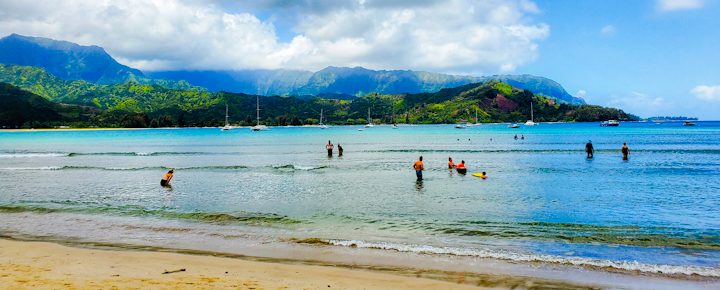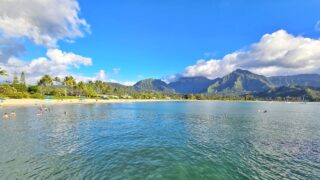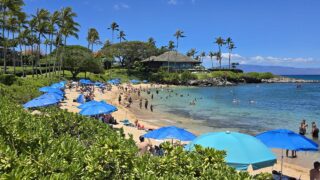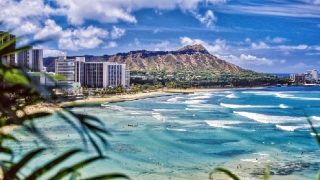A survey led by Professor Jerry Agrusa at the University of Hawaii School of Travel Industry Management reports that if you can’t reduce Hawaii tourism, then at least make it regenerative. Please read on and then, let us know your take. The survey results were also reported in the Journal of Travel Research in June.
Generally applied, the term “regenerative tourism” means leaving any place you visit better than it was when you arrived. With it comes visitor experiences that are non-traditional. For example, planting taro or cleaning up beaches.
We’re trying to imagine those taro fields in Hanalei filled with visitors and if people here really want that. Also, for most of us when we travel, we want a vacation from work and in return hope to some degree we are giving our hard-earned dollars to the local economy. The idea of working on vacation seems counterproductive. We’re wondering too how many Hawaii residents would want to work in the same way when they travel to the mainland for vacation? We mean, regenerative tourism goes both ways.
For this study, UH surveyed 463 Kauai residents (your editors and no one that they know were among them). We have not seen a report as to why only Kauai residents were surveyed and what the demographics of the 463 respondents were like in terms of age, length of residence on Kauai, economic status, ethnicity, and more. As an aside, one of BOH’s editors is a statistician.
The researchers feel they gleaned a different perspective of how Hawaii residents feel about tourism and tourists when there is a focus shift towards this type of travel. UH said that 96% of those surveyed were in favor of regenerative travel, and 99% “responded favorably toward tourist attractiveness,” meaning it made tourists more likable to residents. We’re also wondering how many of our Kauai residents do the volunteer work they want visitors to do?
UH says that the study provides direct evidence for this type of regenerative tourism. Professor Agrusa said, “Before COVID in 2019, there was actually a pushback by the residents of Hawaii, they felt like there were too many tourists—the term ‘over tourism’ came up. [Covid was] an opportunity to stop and say let’s see what we can do to improve tourism from all stakeholder’s perspectives including the residents when we open back up. One of the things that we were able to do is try to target the type of tourist that we want.”
The study about Kauai appears to be intended to have a statewide focus. In it, examples of regenerative activities included replanting native trees to offset greenhouse emissions associated with air travel to Hawaii. Also, working in taro patches to experience Hawaiian culture personally, and helping to clean up beach areas of plastic and old fishing nets.
UH said that the study was designed to link regenerative tourism with “tourist attractiveness,” and to reduce negative feelings towards tourists. Concepts posed in the study included:
1. Tourists visiting Kauai should participate more actively in activities that help in reversing climate change.
2. Residents would like to spend time with tourists who participate in regenerative tourism activities.
3. The volume of tourists visiting Kauai should be increased with this new focus on travel.
The study’s findings are said to include:
1. Regenerative travel positively affects residents’ support for tourism development.
2. Regenerative travel positively affects tourist attractiveness in the eyes of residents.
3. Tourism needs to welcome destination-healing mechanisms (regenerative travel), inclusive of major stakeholders’ involvement (residents and tourists), in order to gradually restore and develop destinations.
Further quote from the study author: “What regenerative tourism does is it brings it to another step. We’re looking at not just sustaining things, but making it better. And when we talk about making it better, we’re talking about the environment, the land, the ocean, the aina, but also the residents… Do we need to diversify from being so tourist dominant? Yes, but it will take time to do that. So, right now with this regenerative tourism, we can now focus on the tourists that want to give back, not just take. And they’re actually those folks that are willing to pay to give back.”
The study seems to raise more questions than it provides answers. Please add your thoughts.
We’re all for regenerative tourism. But can that actually be mandated?
What about visitors who just want to spend their hard-earned dollars on a much-needed vacation? They may simply not want to work but rather come here to enjoy the beauty of Hawaii.
For those who choose to volunteer on vacation, how do they receive that recognition and how do residents know that they volunteered?
How do Hawaii residents feel about participating in regenerative tourism themselves when they travel to the mainland?
Get Breaking Hawaii Travel News







Fascinating dilemma. Looking forward to updates.
Sounds good on the surface.but I do not believe you know the mind set of the well-heeled who travel. Although there are many people who might want to volunteer for a day or 2, those who might agree to longer would want severely reduced accommodations and meals, which you have not considered. Most people want to enjoy the views, the sights, the food, the friendly locals. They do not want to work. A vacation is a holiday, a short respite from their work and responsibilities.Pp
I love Hawaii.live there as a Submarine wife.69-71.only 18 & my first time away from a protective parents.My eanest prayers for the best.I am grateful…
Mahalo for a new perspective on visiting the Islands! I love this idea and would love to give back. When I have visited in the past I would always take my trash and dump it in a trash can. Hawaii is my favorite vacation place. Peggy
Hi Mark P, I have enjoyed your entire comment and have found that the Warning at the end is perfectly crafted and Spot On! There are plenty of different ways that people can make a contribution and possibly a difference in the community by donating their time and effort. You’ve pointed out a few that are interesting and important. Just because they don’t have an immediate effect on what is considered important doesn’t mean that there’s not some kind of collateral substance. Kudos!